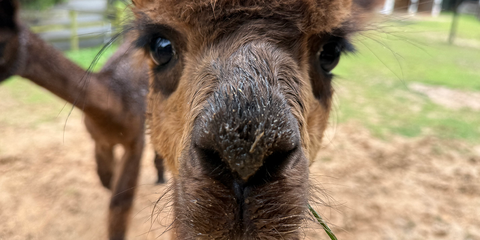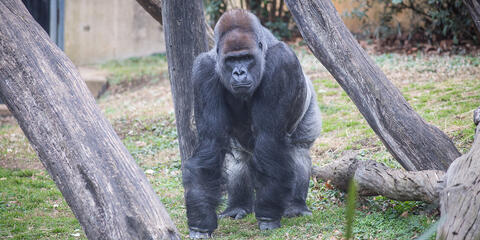Giant pandas are native to central China and have come to symbolize vulnerable species. As few as 1,864 giant pandas live in their native habitat, while another 600 pandas live in zoos and breeding centers around the world.
Physical Description
The giant panda, a black-and-white bear, has a body typical of bears. It has black fur on its ears, eye patches, muzzle, legs, and shoulders. The rest of the animal's coat is white. Although scientists do not know why these unusual bears are black and white, some speculate that the bold coloring provides effective camouflage. In patches of dense bamboo, an immobile giant panda is nearly invisible, and virtually disappears among snow covered rocky outcrops on a mountain slope. This theory does not work, however, when considering that giant pandas have no natural enemies to hide from. Another thought is that the pattern may accentuate social signals in some way, or help giant pandas to identify one another from a distance so they can avoid socializing, as they are typically a solitary animal. Another theory suggests that the black absorbs heat while the white reflects it, helping giant pandas maintain an even temperature. Unfortunately, there is no one conclusive theory as to why giant pandas are black and white.
The giant panda has lived in bamboo forests for several million years. It is a highly specialized animal, with unique adaptations. The panda's thick, wooly coat keeps it warm in the cool forests of its habitat. Giant pandas have large molar teeth and strong jaw muscles for crushing tough bamboo. Many people find these chunky, lumbering animals to be cute, but giant pandas can be as dangerous as any other bear.
Size
About the size of an American black bear, giant pandas stand between 2 and 3 feet (60 to 90 centimeters) tall at the shoulder (on all four legs), and reach 4 to 6 feet (1.2 to 1.8 meters) long. Males are larger than females, weighing up to 250 pounds (113 kilograms) in the wild. Females rarely reach 220 pounds (104 kilograms).
Native Habitat
Giant pandas live in a few mountain ranges in south central China, in Sichuan, Shaanxi and Gansu provinces. They once lived in lowland areas, but farming, forest clearing and other development now restrict giant pandas to the mountains.
Giant pandas live in broadleaf and coniferous forests with a dense understory of bamboo, at elevations between 5,000 and 10,000 feet. Torrential rains or dense mist throughout the year characterizes these forests, often shrouded in heavy clouds.
Lifespan
Scientists are not sure how long giant pandas live in the wild, but they are sure it is shorter than lifespans in zoos. They estimate that lifespan is about 15-20 years for wild pandas and about 30 years for those in human care. Chinese scientists have reported zoo pandas as old as 35. The Smithsonian National Zoo's Hsing-Hsing died at age 28 in 1999.
Communication
Giant pandas do not exhibit body characteristics that communicate visual signals. They have round, inexpressive faces. Their tails are stubs and therefore cannot flag signals to other giant pandas. They have no crest or mane to erect, and their ears are not flexible enough to cock forward or flatten. It is thought that giant pandas never developed these visual accessories due in part to their habitat and solitary nature. Giant pandas live in dense, fog-enshrouded stands of bamboo that obstruct a direct line of sight and any potential visual communications. Giant pandas do occasionally vocalize when playing. During mating, they become very vocal, relying on extremely detailed vocalizations to express all shades of mood from amorous to angry.
Most of their communication is accomplished through scent marking throughout their habitat and territory. Giant pandas mark their territory by rubbing secretions from their anal glands onto tree trunks, rocks or the ground, usually along paths that they habitually tread. Scent marking alerts giant pandas in the vicinity to one another. Depending on who reads the mark, the scents may either separate giant pandas or help bring them together. Outside of breeding season, a scent mark that is unfamiliar is usually enough to send a potential intruder ambling away. During breeding season, however, a female's scent mark advertises her sexual readiness and draws males to her. A female is more likely to accept a male whose scent she recognizes and has encountered before.
Food/Eating Habits
Millions of Zoo visitors enjoy watching giant pandas eat. A panda usually eats while sitting upright, in a pose that resembles how humans sit on the floor. This posture leaves the front paws free to grasp bamboo stems with the help of a "pseudo thumb," formed by an elongated and enlarged wrist bone covered with a fleshy pad of skin. The panda also uses its powerful jaws and strong teeth to crush the tough, fibrous bamboo into bits.
A giant panda's digestive system is more similar to that of a carnivore than an herbivore, and so much of what is eaten is passed as waste. To make up for the inefficient digestion, a panda needs to consume a comparatively large amount of food—from 70 to 100 pounds of bamboo each day—to get all its nutrients. To obtain this much food means that a panda must spend 10 to 16 hours a day foraging and eating. The rest of its time is spent mostly sleeping and resting.
Sleep Habits
In the wild, giant pandas typically nap between feedings for two to four hours at a time, snoozing on their side, back, or belly, either sprawled or curled up. While a giant panda is resting, it continues to defecate. The number of droppings at a rest site can be used to gauge the relative amount of time a giant panda spent at that site. During a short rest of less than two hours, there are five to ten droppings. Eleven to 25 droppings often accompany rests lasting longer than two hours. Most rest periods are two to four hours in duration but may increase to six or more hours during the summer months.
Social Structure
Adult giant pandas may be generally solitary, but they do communicate periodically through scent marks, calls and occasional meetings. Recent research has also found that giant pandas may form communities of seven to 15 individuals within the local population.
These individuals occupy a "group" territory, within which male home ranges overlap almost completely, while female home ranges overlap far less. Members of different "groups" generally avoid socializing with each other. Offspring stay with their mothers from one and a half to three years.
Reproduction and Development
Giant pandas reach breeding maturity between 4 and 7 years of age. They may be reproductive into their 20s. Female pandas ovulate only once a year, in the spring. A short period of two to three days around ovulation is the only time a giant panda is able to conceive. Calls and scents draw males and females to each other.
Female giant pandas give birth from 90 to 180 days after mating. Although females may give birth to two young, usually only one survives. Giant panda cubs may stay with their mothers for up to three years before striking out on their own. This means that a wild female, at best, can produce young only every other year. In a lifetime, a giant panda may successfully raise only five to eight cubs.
The giant pandas' naturally slow breeding rate prevents a population from recovering quickly from illegal hunting, habitat loss and other human-related causes of mortality. At birth, a giant panda cub is helpless, and it takes considerable effort on the mother's part to raise it. A newborn cub weighs 3-5 ounces and is about the size of a stick of butter. Pink, hairless, and blind, the cub is 1/900th the size of its mother. Except for a marsupial, such as a kangaroo or opossum, a giant panda baby is the smallest mammal newborn relative to its mother's size.
Cubs do not open their eyes until they are 6-8 weeks old and are not mobile until they are 3 months old. A cub may nurse for eight to nine months and is nutritionally weaned at 1 year old, but not socially weaned for up to two years.
Conservation Efforts
As few as 1,864 giant pandas live in their native habitat, while another 600 pandas live in zoos and breeding centers around the world. The largest threat to giant panda survival is habitat destruction. People in need of food and income have cleared forests for agriculture and timber. This logging has fragmented a once continuous habitat, leaving small groups of pandas isolated from each other.
When populations become small, they are extremely susceptible to extinction due to environmental or genetic influences, such as drought or inbreeding. Small populations cannot rebound the same way large populations do; as groups of pandas become more isolated, it is more likely that reproduction, disease resistance and population stability will be threatened.
For more than 50 years, the Zoo has celebrated these charismatic bears by creating and maintaining one of the world's foremost panda conservation programs. In that time, the Zoo's team — consisting of dozens of animal care staff, scientists, researchers, international collaborators and conservationists — has made great strides in saving this species from extinction by studying giant panda behavior, health, habitat and reproduction.
Specifically, it has allowed scientists at the Smithsonian's National Zoo and Conservation Biology Institute to learn about panda estrus, breeding, pregnancy, pseudopregnancy and cub development — work that is shared around the world with other institutions that also care for and breed this vulnerable species.
Breeding Giant Pandas
Smithsonian's National Zoo scientists began giant panda research when Ling-Ling and Hsing-Hsing arrived at the Zoo in 1972. See a history and timeline of giant pandas at the Zoo here. Much has been learned since that time, but there still remains much more to learn. With the arrival of Tian Tian and Mei Xiang, the Zoo has developed a ten-year research plan that will hopefully culminate in a growing, thriving population of giant pandas.
Some research areas will repeat behavioral observation studies on Tian Tian and Mei Xiang in order to increase sample size and determine whether a behavior pattern is common to giant pandas or particular to an individual. In other areas, such as reproductive biology, the advanced techniques scientists use today largely did not exist when Ling-Ling and Hsing-Hsing were alive. Also, opportunities for research and conservation initiatives in the wild, including the potential for increasing the wild giant panda population in China through reintroduction, are greater today than at any time in the past. However, these plans and initiatives will be costly to carry out, as will China's official National Plan for the Conservation of Giant Pandas and their Habitats.
Scientists from the Smithsonian Conservation and Biology Institute's Center for Conservation Genomics, have become adept at studying the genetic relatedness of pandas in human care. Chinese colleagues maintain an up-to-date studbook of these vulnerable animals. Zoo scientists developed the formula used to make breeding recommendations for the entire giant panda population in human care, ensuring that it is genetically healthy. Scientists are working to preserve 90 percent of the genetic diversity of the giant panda population in human care.
Panda breeding season is a race against the biological clock. It only comes once a year, and the giant panda team, including scientists from the Smithsonian Conservation Biology Institute's Center for Species Survival, and vets, keepers and biologists from the Zoo's animal care teams, must be ready. Giant panda females, like Mei Xiang, ovulate for just 24 to 72 hours.
To identify the opening of that tiny window, animal keepers carefully watch Mei Xiang for any behavioral sign of estrus. At the same time, scientists monitor hormones in her urine to pinpoint the window when she is ready to breed. If attempts at natural breeding are not successful, scientists can step in, collect fresh or frozen-thawed semen from a male and use the genetic material collected to artificially inseminate a female. At the Zoo, four artificial inseminations have resulted in successful births: male Tai Shan in 2005, female Bao Bao in 2013, male Bei Bei in 2015 and male Xiao Qi Ji in 2020.
Saving Pandas in the Wild
Under the terms of the Zoo's agreement with China, scientists at the Smithsonian Conservation Biology Institute's Conservation Ecology Center have studied these bears both in the wild and in human care.
Smithsonian Conservation Biology Institute ecologists spend months in China every year studying wild pandas and their neighbors, such as Asiatic black bears and takin. They teach colleagues in China how to conduct censuses and surveys of large mammals, including giant pandas that live in the wild, using geographic information systems (GIS) and other high-tech tools for tracking wildlife.
They are also working to identify new landscapes for giant panda reintroduction. Field research has revealed that wild pandas' habitat is highly fragmented, which means pandas have a difficult time finding a mate. To address that problem, Zoo scientists and colleagues have been exploring the possibility of creating "corridors" of forests that link isolated habitats. Such corridors would give giant pandas more options for movement and mate selection. They might also assist with the reintroduction of captive-born pandas into the wild.
The Zoo's pandas are part of Panda Watch behavior study. Each day, dedicated Friends of the National Zoo volunteers, called Panda Watchers, monitor the pandas' behavior via the Panda Cam. Over the years, they've amassed mountains of data on the species, which is notoriously difficult to study in the wild.
The Future
In December 2011, David M. Rubenstein donated $4.5 million to the Zoo to fund the giant panda program through 2016. In appreciation, the giant panda complex was named the David M. Rubenstein Family Giant Panda Habitat. In addition, young conservation biologists in the U.S. and in China who were awarded Smithsonian's National Zoo fellowships for their work to save this vulnerable species were named "David M. Rubenstein Fellows." The gift was used to fund conservation efforts in China, reproductive science, professional training programs, giant panda care at the Zoo, upgrades to the Zoo habitats and public education. Mr. Rubenstein provided an additional $4.5 million donation in fall 2015.
The gift allowed the Zoo's animal care and the Smithsonian Conservation Biology Institute's scientific team to proceed with the five-year science plan established with their Chinese colleagues from the China Wildlife Conservation Association. The science plan had specific goals: to examine the creation and impact of corridors to link fragmented habitats that will benefit giant pandas and other wildlife species, including promoting genetic diversity; examine how to restore habitats, especially those where pandas appear to be making a comeback; provide advice on giant panda reintroduction; examine the potential impact of transmissible diseases on giant pandas and other wildlife species, including providing advice on implementing new programs associated with a Wildlife Disease Control Center being built in Sichuan Province; and continue research on giant panda reproduction and management, because, although there has been major success in Chinese breeding centers, some pandas still experience reproductive challenges.
In 2020, Mr. Rubenstein pledged a $3 million gift to the Smithsonian's National Zoo and Conservation Biology Institute, funding its giant panda research and conservation program through the end of 2023. As per the Zoo's original agreement with the China Wildlife Conservation Association, any cub born to Mei and Tian would be sent to a breeding center in one of the panda reserves in China sometime after the cub turned two years old. In April 2007, it was determined that Tai Shan would remain at the Zoo an additional two years past his second birthday, which was July 9, 2007. This extension allowed Tai Shan to become an adolescent bear in front of his fans. What's more, Zoo scientists were able to continue their studies of his growth and development to document changes during this little-known stage of a panda's life.
On February 2010, Tai Shan was sent back to China, per the loan agreement, to a breeding center in Bifengxia, China. The new loan, which was agreed upon in 2010, states that any cub born at Zoo will stay for four years. Bao Bao, Mei Xiang's second surviving cub born Aug. 23, 2013, departed for China on Feb. 21, 2017. Bei Bei, Mei Xiang's cub born Aug. 22, 2015, departed the Zoo for China Nov. 19, 2019.
Help this Species
- Support organizations like the Smithsonian’s National Zoo and Conservation Biology Institute that research better ways to protect and care for this animal and other endangered species. Consider donating your time, money or goods.
- Share the story of this animal with others. Simply raising awareness about this species can contribute to its overall protection.
Animal News

Zoo Welcomes Alpacas ‘Rainstorm’ and ‘Coffee Cup’


